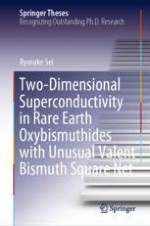This book elucidates fascinating electronic phenomena of unusual Bi2-square net in layered R2O2Bi (R: rare earth) compounds using two approaches: the fabrication of epitaxial thin films and the synthesis of bulk polycrystalline powders. The Bi2-square net compounds are a promising platform to explore exotic physical properties originating from the interplay between a two-dimensional electronic state and strong spin–orbit coupling; however, there are few reports on Bi2-square net compounds due to the instability of unusual electronic configurations.
The book presents the development of synthetic routes for R2O2Bi compounds, such as novel solid phase epitaxy techniques and chemical control of crystal structure, demonstrating the intrinsic physical properties of Bi2-square net for the first time. The most notable finding is the successful induction of two-dimensional superconductivity in Bi2-square net with the coexistence of rich electronic phases. The book also discusses the superconducting mechanisms and the effect of R cation substitution in detail and describes the mechanical properties of Bi2-square net. These findings overturn the results of previous studies of R2O2Bi. The book sheds light on hidden layered compounds, representing a significant advance in the field.
